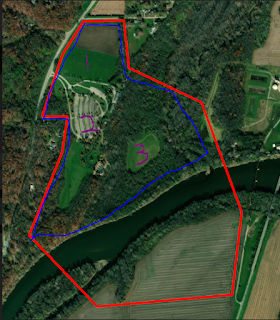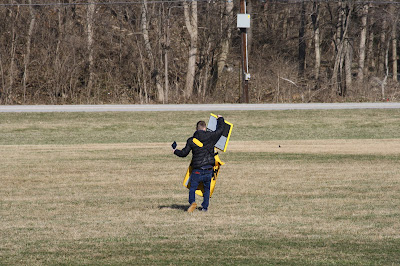First Successful Bramor Flight
On March 27th, we completed our first flight with the C-astral Bramor. The operation ran smoothly with a successful data collection and landing. The weather for the day was around 50 degrees and winds were below 5 mph, creating excellent flight conditions. In order to assure safe procedures and proper flight execution, we followed our checklists closely. It was very beneficial to perform the dry runs from a couple weeks back. Because we ran those dry runs, we felt secure in how the operation was going to run, and eliminated confusion from happening in the field.
To begin the flight day, I arrived early to the classroom along with Evan to plan out the mission, as well as go back over the recovery and parachute procedures for the aircraft. While we were there, Ian and Todd were packing a fresh parachute for this flight mission. The parachute must be packed no more than 24 hours in advance of the flight time. After these tasks were complete, Evan (PIC) and I (co-pilot) completed the in-office checklist consisting of making sure everything is packed and charged. I recommend that every flight crew assembles an "In-office" checklist. There have been multiple instances throughout my 4 years in school that we have forgotten to bring something important or forgot to charge a tablet, and not noticed until arriving to the field. By creating and going through this checklist, this can eliminate any wasted field days.
The crew for the flight goes as follows:
This being our first flight, one of the things that I took into heavy consideration was spreading visual observers as far as possible so as to eliminate the risk of losing sight of the aircraft. To do this, I designated 3 groups of observers scattered around the park, and constant communication was kept by using the radio app "zello" on our phones.
At the beginning of the operation, Thomas (right) and myself brought out the aircraft to our designated takeoff zone. We choose the south fields for our takeoff zone because it gave us ample room to takeoff and the only obstructions were a few soccer goals that we moved out of the way.
As I began to walk through the checklists with Evan, I assigned other members of our crew to other important tasks. Above, Ian (left) and Thomas (right) are gathering weather information. The temperature is needed when we are initializing the sensors about midway through the checklist, and the wind direction is important for determining which direction we takeoff. We receive the best climb by launching into a headwind. Below is a picture of Dylan walking around the field placing ground control points. We use AeroPoints which uses GPS technology to locate itself at just the push of a button.
The Bramor is a catapult launched aircraft. I have never launched from a catapult before, so the practice the last few weeks was very beneficial in learning how to properly load and arm the catapult. Shown above is Todd (bottom of catapult) and Dr. Hupy (Green Beanie) placing on the catapults rubbers. These draw back the platform and give it tension to launch the aircraft. One of the problems that we ran into our first few times was placing the rubbers in the correct order, because if the rubbers are tangled under tension then the platform will not properly launch and may cause damage to the catapult and or the aircraft.
We will be completing more flights with this aircraft in the future, and I will keep my blog updated with the data collected.
To begin the flight day, I arrived early to the classroom along with Evan to plan out the mission, as well as go back over the recovery and parachute procedures for the aircraft. While we were there, Ian and Todd were packing a fresh parachute for this flight mission. The parachute must be packed no more than 24 hours in advance of the flight time. After these tasks were complete, Evan (PIC) and I (co-pilot) completed the in-office checklist consisting of making sure everything is packed and charged. I recommend that every flight crew assembles an "In-office" checklist. There have been multiple instances throughout my 4 years in school that we have forgotten to bring something important or forgot to charge a tablet, and not noticed until arriving to the field. By creating and going through this checklist, this can eliminate any wasted field days.
The crew for the flight goes as follows:
- Evan Hockridge -- Pilot in Command
- Kyle Sheehan -- Co-pilot
- Ian Wiley, Todd Horn, Thomas Gonya -- equipment setup / visual observer
- Krysta Rolle, Dylan McQueen -- Ground control / visual observer
- Ryan Ferguson -- visual observer (also took the pictures shown below)
This being our first flight, one of the things that I took into heavy consideration was spreading visual observers as far as possible so as to eliminate the risk of losing sight of the aircraft. To do this, I designated 3 groups of observers scattered around the park, and constant communication was kept by using the radio app "zello" on our phones.
- The red outline indicates the entire area that we hop to fly throughout the duration of the course
- The blue outline indicates the area we flew in the first mission
- The purple numbers show where observers/pilots were placed
- 1 -- Evan, Dr. Hupy, and myself
- 2 -- Todd and Thomas
- 3 -- Ryan, Dylan, and Krysta
- Ian was wandering the site during the flight trying to find new areas that may be beneficial to observe from in future flights.
At the beginning of the operation, Thomas (right) and myself brought out the aircraft to our designated takeoff zone. We choose the south fields for our takeoff zone because it gave us ample room to takeoff and the only obstructions were a few soccer goals that we moved out of the way.
As I began to walk through the checklists with Evan, I assigned other members of our crew to other important tasks. Above, Ian (left) and Thomas (right) are gathering weather information. The temperature is needed when we are initializing the sensors about midway through the checklist, and the wind direction is important for determining which direction we takeoff. We receive the best climb by launching into a headwind. Below is a picture of Dylan walking around the field placing ground control points. We use AeroPoints which uses GPS technology to locate itself at just the push of a button.
The Bramor is a catapult launched aircraft. I have never launched from a catapult before, so the practice the last few weeks was very beneficial in learning how to properly load and arm the catapult. Shown above is Todd (bottom of catapult) and Dr. Hupy (Green Beanie) placing on the catapults rubbers. These draw back the platform and give it tension to launch the aircraft. One of the problems that we ran into our first few times was placing the rubbers in the correct order, because if the rubbers are tangled under tension then the platform will not properly launch and may cause damage to the catapult and or the aircraft.
We will be completing more flights with this aircraft in the future, and I will keep my blog updated with the data collected.






Comments
Post a Comment